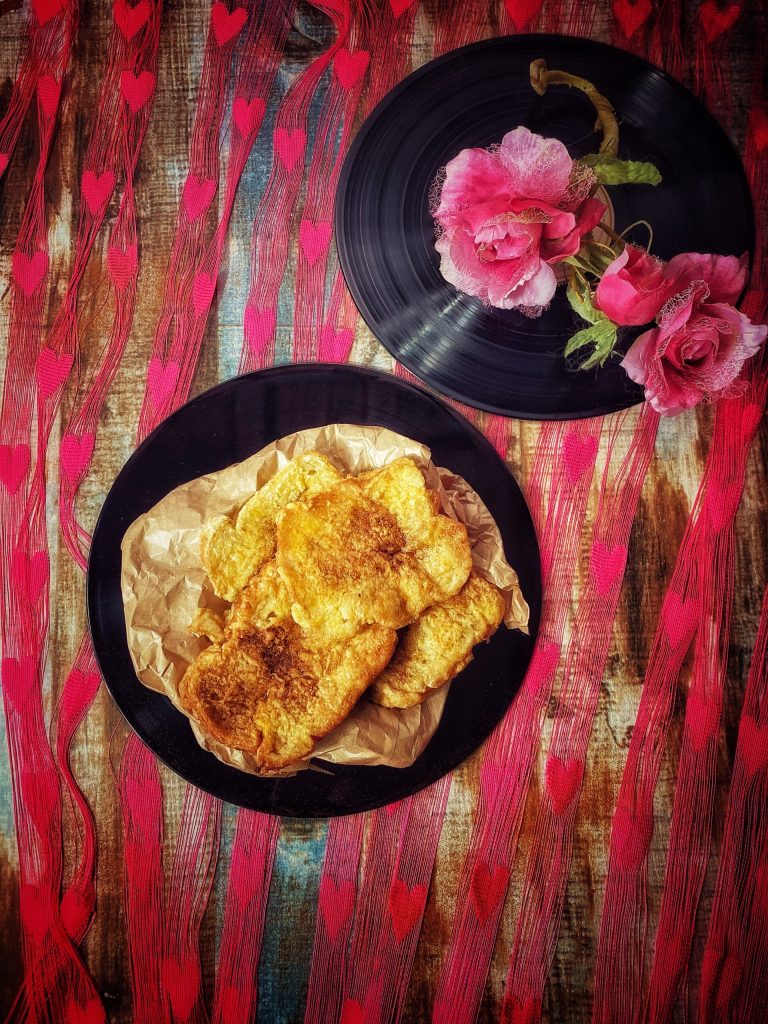Torrejas or torrijas are made of slices of bread (usually several days old) soaked in milk or wine (white wine, sweet muscat wine, or sweet dessert wine) and, after being coated with eggs and flour, fried in a pan.
They are sweetened with honey syrup, molasses or sugar and flavored with cinnamon.
Bread dipped in milk and sweetened was widely known in medieval Europe by the names suppe dorate, soupys yn dorye, tostées dorées or dolore perdu in France and was often served as a garnish for game dishes, such as partridges and pheasants.
In Spain, the term “torrija” or “torreja” appeared in the 15th century.
The Spanish conquistadors brought them to Latin America.
In Argentina and Uruguay, the recipe involves soaking the bread in milk, dipping it in egg, frying it in oil, and then sprinkling it with sugar and cinnamon or drizzling it with syrup.
The recipe is dedicated to the song “Colpo di fulmine” written by Gianna Nannini and sung by Giò Di Tonno and Lola Ponce, an Argentinean model and singer.
In 2008, they won the 58th Sanremo Music Festival in a duet with Giò Di Tonno, known from “Notre Dame de Paris”: with the victory, she became the second foreign singer to have won the Sanremo Festival after Romina Power.

- Difficulty: Very easy
- Cost: Very cheap
- Preparation time: 8 Hours 10 Minutes
- Portions: 2 people
- Cooking methods: Stovetop, Frying
- Cuisine: Argentinian
- Seasonality: All seasons
Ingredients
- 4 slices bread (stale or sandwich loaf)
- 3/4 cup milk
- 2 tbsp flour
- 2 eggs
- to taste peanut oil
- to taste cinnamon
- 2 tbsp sugar (+ decoration)
Steps
With the milk, heat the milk with sugar and cinnamon in a saucepan.
Before it reaches a boil, remove it and pour it over the slices of bread, leaving them to soak in a bowl for 30 minutes.
Then pass them through flour and egg and fry in plenty of hot oil.
When golden, drain them and transfer to a bowl where they are sprinkled with sugar and cinnamon. Serve hot.
With the wine: moisten the bread with slightly salted water and let it rest for a few hours.
Then beat the eggs, dip the slices of bread and flour them to fry on both sides in a pan with olive oil.
They can be served either hot or cold.
For the syrup: prepare a syrup by heating water with honey, sugar, and molasses in equal parts, mixing the mixture well to make it homogeneous. Add on top of the torrejas.

The 58th Sanremo Music Festival took place from February 25 to March 1, 2008, hosted by Pippo Baudo, also artistic director, and Piero Chiambretti, accompanied by actresses Bianca Guaccero and Andrea Osvárt.
This edition was unfortunate in terms of viewership: with a 35.64% share, it is indeed the least watched ever.
This edition was unfortunate in terms of viewership: with a 35.64% share, it is indeed the least watched ever.
For the second time in its history, the Sanremo Festival was surpassed in ratings by another program: Friday night’s episode was beaten by the fifth episode of the second season of the fiction I Cesaroni, aired on Canale 5.
It was the last edition of the Festival hosted by Baudo, who holds the record for the most Sanremo Festivals presented.
FAQ (Frequently Asked Questions)
What are other versions of torrejas around the world?
In Cuba, torrejas are considered a traditional dessert and served with syrup, although on special occasions they are covered with custard (crema pastelera).
In El Salvador, torrejas are usually accompanied by a hot drink called chilate and made with a brioche egg bread called torta de yema, which is one or two days old.
In Central American countries and Chiapas, they are called “torreja”: bread coated in eggs and fried in butter, usually dipped in panela.
Hong Kong French toast involves slices of bread fried in egg or soy batter, served with butter and topped with honey or cane syrup.
In Brazil, torrejas are called rabanada, in the United States French toast.
In France, they are pain perdu, which, although similar, is not battered, and there is no wine version; it is cooked with less oil or in a layer of butter.
In Canada, maple syrup is used instead of sugar or honey, and the name “pain doré” (golden bread) is used instead of “pain perdu” (lost bread).

